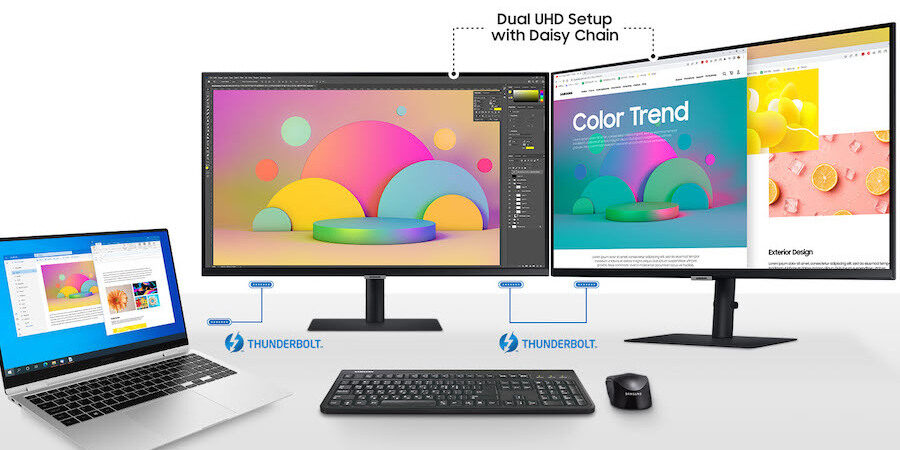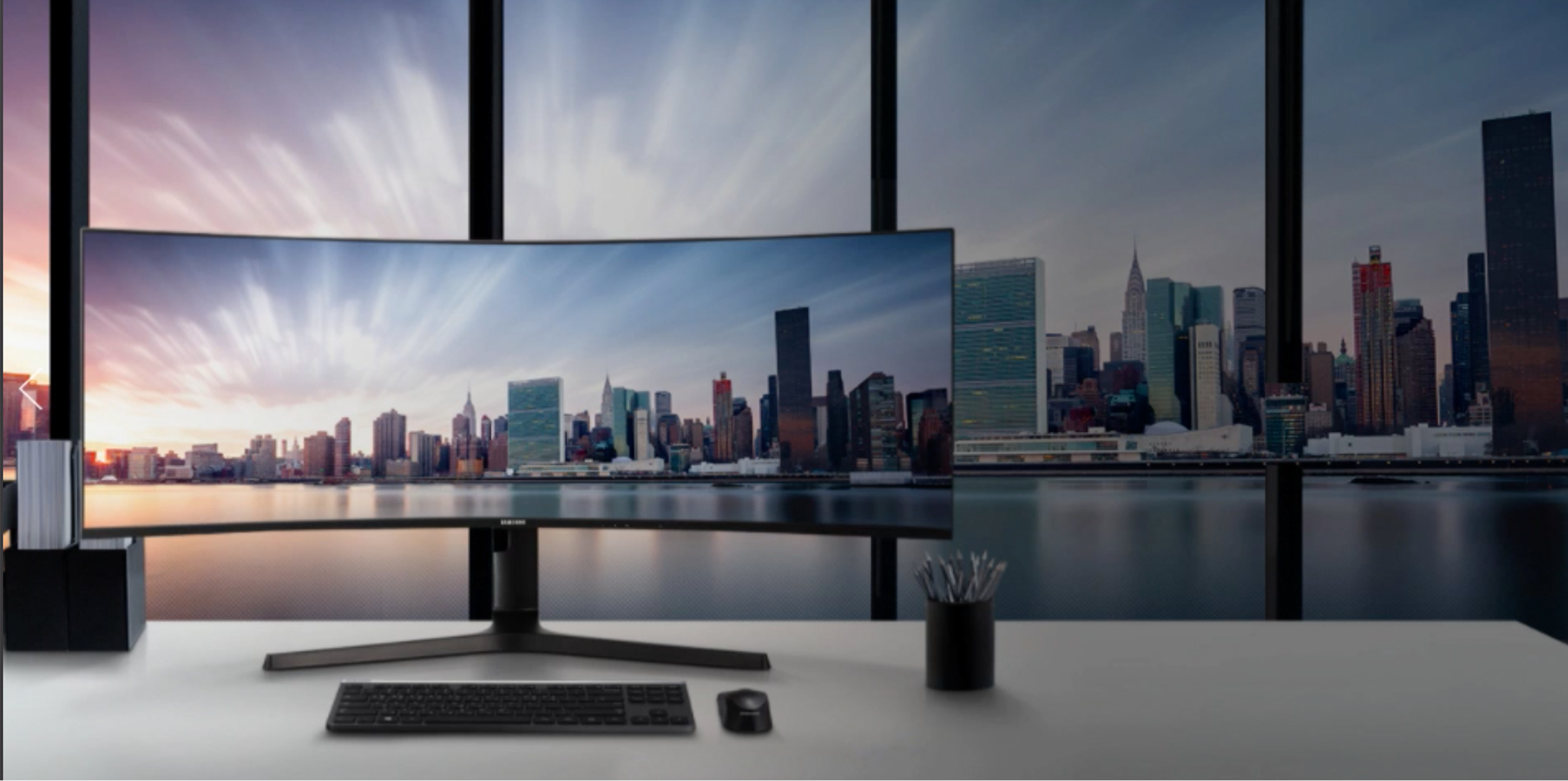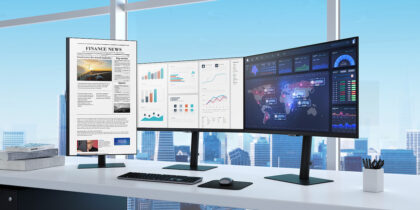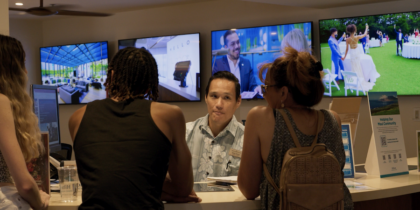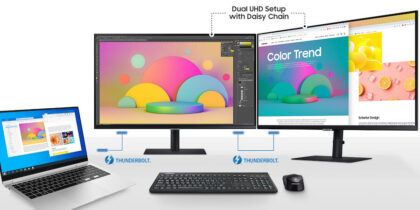Not long ago, Thunderbolt 3 was the latest and greatest technology because it combined Thunderbolt, USB, DisplayPort, Ethernet and power via a single USB-C connector. Thunderbolt 4, released in 2020, raised the game even higher — with all of the benefits of Thunderbolt 3 but also the ability to send local area network (LAN) signals between devices.
One look at a typical workstation in nearly any working environment is enough to explain the allure of this technology. Where there is typically a messy tangle of cables to operate a monitor and peripherals, there can be one cord doing just about everything instead.
Besides decluttering workstations, Thunderbolt 4 is less expensive than other connection technologies and supports desktop IT demands, such as greater data transfer speeds — eight times faster than conventional USB 3.0 cables. Thunderbolt 4 monitors have everything in one bundle.
A monitor is, by nature, the center of attention and activity at any desk — but with a Thunderbolt 4 port, it becomes a command center. Here’s how.
What is Thunderbolt 4?
Often, there is confusion when comparing Thunderbolt vs. USB-C, as the terms are commonly used interchangeably. However, they are not the same.
Upgrade your monitor fleet
Calculate the total cost of ownership of upgrading your business's monitors with five easy questions. Download Now
USB-C refers to the physical port used for connecting and powering devices. That port is the product of an industry-developed standard, USB 3.1, intended to streamline the many cables typically found at a workstation into a single cable that does all the work while improving performance.
Thunderbolt 4, meanwhile, is a powerful connectivity standard that uses both USB-C ports and the USB 3.1 standard. In other words, a Thunderbolt 4 connector and cable uses USB 3.1, but a USB-C connector isn’t necessarily Thunderbolt 4.
Some devices and cables that use USB-C can only connect, as older versions of USB have done for many years. A USB-C device that uses Thunderbolt 4, however, has a wide range of capabilities that make computing simpler and faster for business users and IT administrators. So, while comparisons between Thunderbolt and USB-C are common, Thunderbolt 4 offers far more capabilities.
You’ll know a cable is Thunderbolt 4 if there’s a lightning bolt icon on the connector tip. A standard USB-C cable will just have the familiar three-pronged USB logo.
Thunderbolt 4 takes USB 3.1 and optimizes its potential. It has all the USB-C single connector benefits, plus blazing fast data transfers — 40GB/s — on the same cable while doing other work.
Using Thunderbolt 4 means:
- Charging with up to 90W power delivery
- Data transfers eight times faster than USB 3.0 (you could transfer a 4K movie in less than 30 seconds)
- Sending a LAN signal by connecting the LAN cable to a monitor
- Four times more video bandwidth than HDMI
- Backups of entire music archives in a few minutes
Thunderbolt 3 vs. 4: Key differences
The leap from Thunderbolt 3 to Thunderbolt 4 includes several key improvements. Here’s a quick breakdown of the advantages of Thunderbolt 3 vs. 4:
Screen expansion: Thunderbolt 4 can support 4K on dual monitors and 8K on a single monitor. By comparison, Thunderbolt 3 can also support 4K on dual monitors but only 5K on a single monitor.
Data transfer: With even faster transfer speeds, Thunderbolt 4 supports a PCIe® data transfer speed of up to 32GB/s, double the data transfer speed of Thunderbolt 3 monitors (16GB/s PCIe).
Sleep mode: A new feature on Thunderbolt 4 allows users to wake up their laptop with an external keyboard or mouse. As long as the peripheral devices are connected via the Thunderbolt 4 port, it’s simple to wake up the screen and jump back into work.
The benefits of Thunderbolt 4
One connection from a laptop or desktop PC to a Thunderbolt 4-ready monitor enables full office productivity. Power, data and display transmissions all happen via that single cable, and all peripherals and devices are connected, too.
Connecting a Thunderbolt 4 cable from the PC to the monitor provides a high-speed, 8K-ready display signal and supports multiple peripherals. Thunderbolt 4 is also bidirectional: While the cable sends a signal and commands to the screen, the screen can send back power to charge the laptop.
Some monitors that support Thunderbolt 4 have more than one USB-C connector at the rear, so they can connect to a PC while the second port does something else, like daisy chaining the signal to a second screen. The monitor can also become a USB hub, with conventional USB ports that connect peripherals like a mouse and an external keyboard.
A fully equipped Thunderbolt 4 monitor largely eliminates the need for a docking station at a work desk, which is great for large businesses, as a single docking station can be costly. Docking stations are peripheral devices with software drivers and firmware, so they sometimes need updating and troubleshooting. USB-C reduces connections and, therefore, their potential to loosen, break or go missing.
One of the simplest attractions of using USB-C connectors is the reversible oval connector, which has no top or bottom. There’s no more inadvertently bending or breaking parts because they don’t fit, which means lower replacement costs and productivity loss.
Taking full advantage of Thunderbolt ports
It’s important for businesses and individuals upgrading their monitors to understand the differences between Thunderbolt 4 and USB-C. This way, they don’t accidentally buy something that looks like it supports Thunderbolt 4 but doesn’t.
Here’s what to look for:
- Cables: A Thunderbolt 4 cable is different from a USB-C cable. Their connectors are the same, but even a genuine USB-C cable that’s fully USB 3.1-compatible will have slower data transfer speeds than Thunderbolt 4. Look for the lightning bolt on the connector end and buy from a familiar brand. An inexpensive offshore cable may have a lightning bolt but no capabilities.
- PCs: It’s good for a laptop to have a USB-C port, but the port doesn’t guarantee the laptop supports all of the USB-C standard’s capabilities. PC Magazine found that some manufacturers haven’t fully developed their graphics hardware to optimize USB-C connections. In other words, you may still need a VGA or HDMI cable to connect to certain displays. Also, not all laptops or desktop PCs will support power input through a USB-C port.
- Monitors: As you sift through monitor options, evaluate USB-C power delivery support, which lets a user connect one USB-C cable from their laptop to the monitor, support multiple peripherals and simultaneously charge their laptop. This added functionality gives employees peace of mind during the workday since they won’t need to scramble for a charging cord.
Function meets form
There are still very few Thunderbolt 4 monitor options on the market. Samsung ViewFinity TU874 features two Thunderbolt 3 ports. Users can easily expand their screen by connecting compatible monitors for a dual ultra-high-definition (UHD) setup, all while charging their devices with a single cable.
To level up to Thunderbolt 4, look to the Samsung S65TC 34-inch monitor. Its widescreen, curved display is tailored to users who need a big canvas and enough power to work on one or multiple demanding tasks at once easily. With multiple ports, including Thunderbolt 4, built-in speakers and TÜV certification for intelligent eye care, Samsung S65TC ups the productivity ante.
Ready to declutter your workspace? Explore Thunderbolt 4-enabled Samsung computer monitors. Also, learn more about how to daisy chain monitors to create the perfect workstation.
